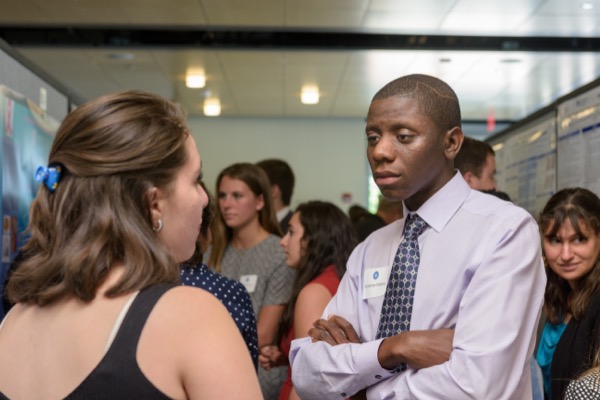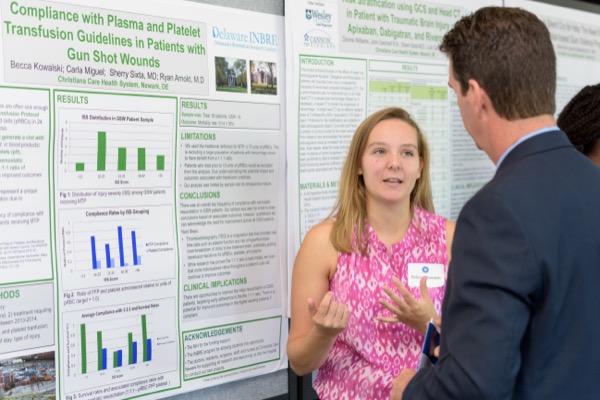


Summer Scholars
Summer stretch helps record number of undergrads build research momentum
2:23 p.m., Aug. 20, 2015--More than 400 students – a record crowd – showed up at the University of Delaware’s Harker Interdisciplinary Science and Engineering Laboratory last week to talk about how they invested their time as Summer Scholars.
They had a lot to cover at the sixth annual Celebratory Symposium that marked the end of the 10-week program. Students from all seven colleges and about three dozen other institutions – Amherst, Columbia, Cornell, Delaware State, Duke, Georgia State, Western Oregon, Penn State and Rochester, to name a few – participated, explaining their research with faculty mentors or their work with community partners in service-learning projects.
Research Stories
Chronic wounds
Prof. Heck's legacy
They explored everything from Jamaica's dancehall music to how camera optics can provide navigational assistance in thick fog or smoke, the difference in how assault victims report crimes to police in the United States, Argentina and South Africa, and ways to use visual arts to enhance third-grade English curriculum.
They helped international refugees resettle in Baltimore, analyzed the water quality of Brandywine Creek, studied how bone pain from metastatic prostate cancer might be addressed and looked for ways to keep dairy cattle feed from spoiling.
They investigated the mechanics of fuel cell membranes, evaluated rectangular room acoustics, learned about zooplankton and analyzed a vast array of chemical and biological reactions, interactions, causes, effects, synthetics, catalytics and mathematical calculations too numerous to portray here.
"This is the University of Delaware at its best," said Iain Crawford, director of Undergraduate Research and Experiential Learning. "And this is our favorite day of the year. A lot of what they do is invisible to us – they're off in their labs or with community partners doing their work. But this is one day where we all get together and see the amazing things everyone has been doing."
Dozens of projects were part of the Delaware INBRE (IDeA Networks of Biomedical Research Excellence) program, which includes partnerships with UD, Delaware State University, Wesley College, Delaware Technical Community College, Christiana Care Health System and Nemours/Alfred I. duPont Hospital for Children. Delaware INBRE is designed to build research capacity in the state, drawing support from the National Institutes of Health and the state of Delaware.
Markia Smith, a junior majoring in biochemistry and neuroscience, was a Delaware INBRE summer scholar, working with research mentor John Slater, assistant professor of biomedical engineering.
Her work focused on cellular mechanisms and a biosensor known as the FRET-based vinculin tension sensor, which helps scientists measure molecular forces. FRET stands for Förster energy resonance transfer.
"I love it," she said. "I have done research two other times, but this was a lot more hands-on."
Smith, of Wilmington, plans to pursue a medical degree and a Ph.D.
David Eldridge, a senior electrical engineering major, worked on developing navigational tools to use in opaque conditions – smoke or fog, for example – when GPS devices are inaccessible for whatever reason. It's a project in which the U.S. Army is interested.
Eldridge and the researchers he worked with explored the performance of different camera types – Aptina image sensor (silicon-based), TriWave (germanium-based) and FLIR (microbolometer) – showing their ability to detect features in low-visibility conditions.
With their analysis they were able to show the direction and rate of movement.
"By the end of our testing, the FLIR camera dominated in the low-visibility environment," he said. But it had limitations that led them to recommend a combination of cameras for best results.
Kimani DeShields-Williams, a senior from Salisbury, Maryland, said her service-learning work with the International Rescue Committee in Baltimore, where she helped to resettle refugees from Burma and other areas, sealed her desire to pursue a career in humanitarian work and the Foreign Service.
The Baltimore office is one of 22 IRC offices in the United States. DeShields-Williams said about six months of support is offered to refugees, who arrive after enduring life-threatening conditions including civil wars, natural disasters and the instability and difficulties of refugee camps. They get help to find lodging, food and employment.
"I wanted a project that would help me learn more about the world," she said during her presentation. Now, she wants to do much more work in this area.
Lucas Schurman, a music education major from Harrington, Delaware, found similar inspiration in his work with ProjectMUSIC at two Wilmington schools – Christina School District's Etta Wilson Elementary and Red Clay School District's Richardson Park Elementary.
The project is student-run and promotes "teaching artists," accomplished university musicians who take their music and knowledge into schools, he said during his presentation. Ensembles go into the schools six times a year.
"It adds spark to each classroom, teaches university students about teaching artistry and provides school children with real examples of artists," he said.
Schurman said he studied the work of El Sistema, a Venezuela-based program founded by José Antonio Abreu that has inspired similar programs around the world, and met with Stanford Thompson, who directs Play On, Philly, a year-round music program that reaches hundreds of kids in Philadelphia.
Schurman hopes to continue – and expand – his work next year.
"Undergraduate research is becoming increasingly important nationally," Crawford said, "and UD has a long tradition of more than three decades. It's a great program and we're a big tent."
Those with interest can have a look at what nine students were up to by visiting the University's Pinterest page, where a display with a baseball card theme is posted.
Article by Beth Miller
Photos by Evan Krape









